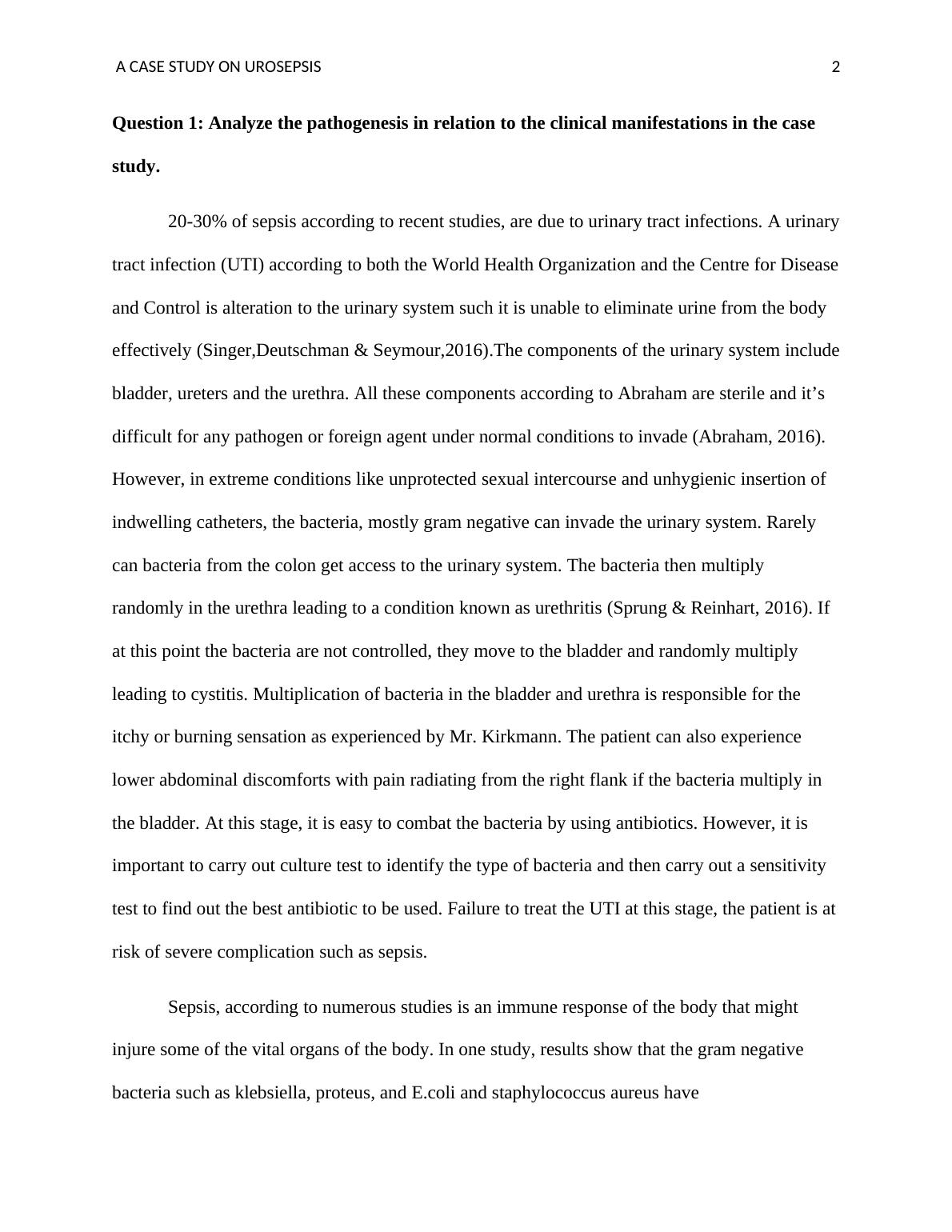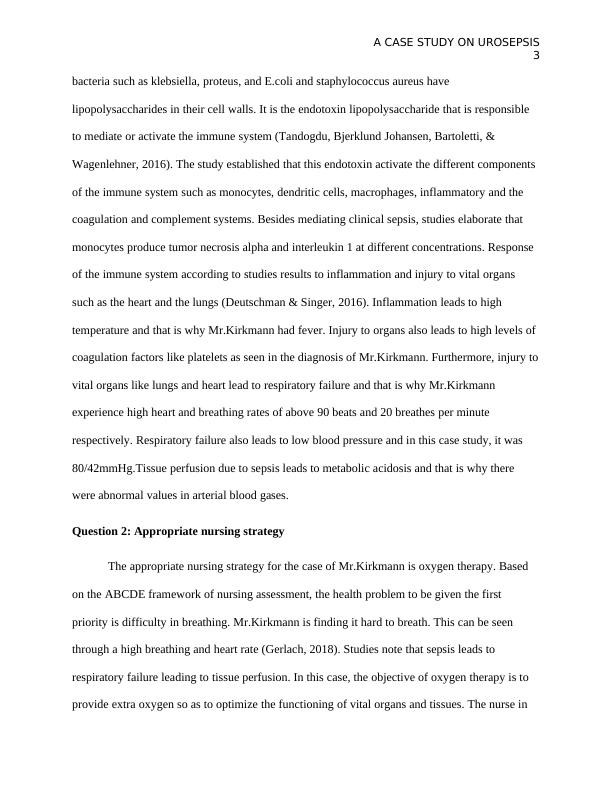A Case Study on Urosepsis
Added on 2023-01-10
7 Pages1800 Words84 Views
Running head: A CASE STUDY ON UROSEPSIS
1
A case study on urosepsis
Name:
Institution:
Tutor:
Date:
1
A case study on urosepsis
Name:
Institution:
Tutor:
Date:

A CASE STUDY ON UROSEPSIS
2
Question 1: Analyze the pathogenesis in relation to the clinical manifestations in the case
study.
20-30% of sepsis according to recent studies, are due to urinary tract infections. A urinary
tract infection (UTI) according to both the World Health Organization and the Centre for Disease
and Control is alteration to the urinary system such it is unable to eliminate urine from the body
effectively (Singer,Deutschman & Seymour,2016).The components of the urinary system include
bladder, ureters and the urethra. All these components according to Abraham are sterile and it’s
difficult for any pathogen or foreign agent under normal conditions to invade (Abraham, 2016).
However, in extreme conditions like unprotected sexual intercourse and unhygienic insertion of
indwelling catheters, the bacteria, mostly gram negative can invade the urinary system. Rarely
can bacteria from the colon get access to the urinary system. The bacteria then multiply
randomly in the urethra leading to a condition known as urethritis (Sprung & Reinhart, 2016). If
at this point the bacteria are not controlled, they move to the bladder and randomly multiply
leading to cystitis. Multiplication of bacteria in the bladder and urethra is responsible for the
itchy or burning sensation as experienced by Mr. Kirkmann. The patient can also experience
lower abdominal discomforts with pain radiating from the right flank if the bacteria multiply in
the bladder. At this stage, it is easy to combat the bacteria by using antibiotics. However, it is
important to carry out culture test to identify the type of bacteria and then carry out a sensitivity
test to find out the best antibiotic to be used. Failure to treat the UTI at this stage, the patient is at
risk of severe complication such as sepsis.
Sepsis, according to numerous studies is an immune response of the body that might
injure some of the vital organs of the body. In one study, results show that the gram negative
2
Question 1: Analyze the pathogenesis in relation to the clinical manifestations in the case
study.
20-30% of sepsis according to recent studies, are due to urinary tract infections. A urinary
tract infection (UTI) according to both the World Health Organization and the Centre for Disease
and Control is alteration to the urinary system such it is unable to eliminate urine from the body
effectively (Singer,Deutschman & Seymour,2016).The components of the urinary system include
bladder, ureters and the urethra. All these components according to Abraham are sterile and it’s
difficult for any pathogen or foreign agent under normal conditions to invade (Abraham, 2016).
However, in extreme conditions like unprotected sexual intercourse and unhygienic insertion of
indwelling catheters, the bacteria, mostly gram negative can invade the urinary system. Rarely
can bacteria from the colon get access to the urinary system. The bacteria then multiply
randomly in the urethra leading to a condition known as urethritis (Sprung & Reinhart, 2016). If
at this point the bacteria are not controlled, they move to the bladder and randomly multiply
leading to cystitis. Multiplication of bacteria in the bladder and urethra is responsible for the
itchy or burning sensation as experienced by Mr. Kirkmann. The patient can also experience
lower abdominal discomforts with pain radiating from the right flank if the bacteria multiply in
the bladder. At this stage, it is easy to combat the bacteria by using antibiotics. However, it is
important to carry out culture test to identify the type of bacteria and then carry out a sensitivity
test to find out the best antibiotic to be used. Failure to treat the UTI at this stage, the patient is at
risk of severe complication such as sepsis.
Sepsis, according to numerous studies is an immune response of the body that might
injure some of the vital organs of the body. In one study, results show that the gram negative

A CASE STUDY ON UROSEPSIS
3
bacteria such as klebsiella, proteus, and E.coli and staphylococcus aureus have
lipopolysaccharides in their cell walls. It is the endotoxin lipopolysaccharide that is responsible
to mediate or activate the immune system (Tandogdu, Bjerklund Johansen, Bartoletti, &
Wagenlehner, 2016). The study established that this endotoxin activate the different components
of the immune system such as monocytes, dendritic cells, macrophages, inflammatory and the
coagulation and complement systems. Besides mediating clinical sepsis, studies elaborate that
monocytes produce tumor necrosis alpha and interleukin 1 at different concentrations. Response
of the immune system according to studies results to inflammation and injury to vital organs
such as the heart and the lungs (Deutschman & Singer, 2016). Inflammation leads to high
temperature and that is why Mr.Kirkmann had fever. Injury to organs also leads to high levels of
coagulation factors like platelets as seen in the diagnosis of Mr.Kirkmann. Furthermore, injury to
vital organs like lungs and heart lead to respiratory failure and that is why Mr.Kirkmann
experience high heart and breathing rates of above 90 beats and 20 breathes per minute
respectively. Respiratory failure also leads to low blood pressure and in this case study, it was
80/42mmHg.Tissue perfusion due to sepsis leads to metabolic acidosis and that is why there
were abnormal values in arterial blood gases.
Question 2: Appropriate nursing strategy
The appropriate nursing strategy for the case of Mr.Kirkmann is oxygen therapy. Based
on the ABCDE framework of nursing assessment, the health problem to be given the first
priority is difficulty in breathing. Mr.Kirkmann is finding it hard to breath. This can be seen
through a high breathing and heart rate (Gerlach, 2018). Studies note that sepsis leads to
respiratory failure leading to tissue perfusion. In this case, the objective of oxygen therapy is to
provide extra oxygen so as to optimize the functioning of vital organs and tissues. The nurse in
3
bacteria such as klebsiella, proteus, and E.coli and staphylococcus aureus have
lipopolysaccharides in their cell walls. It is the endotoxin lipopolysaccharide that is responsible
to mediate or activate the immune system (Tandogdu, Bjerklund Johansen, Bartoletti, &
Wagenlehner, 2016). The study established that this endotoxin activate the different components
of the immune system such as monocytes, dendritic cells, macrophages, inflammatory and the
coagulation and complement systems. Besides mediating clinical sepsis, studies elaborate that
monocytes produce tumor necrosis alpha and interleukin 1 at different concentrations. Response
of the immune system according to studies results to inflammation and injury to vital organs
such as the heart and the lungs (Deutschman & Singer, 2016). Inflammation leads to high
temperature and that is why Mr.Kirkmann had fever. Injury to organs also leads to high levels of
coagulation factors like platelets as seen in the diagnosis of Mr.Kirkmann. Furthermore, injury to
vital organs like lungs and heart lead to respiratory failure and that is why Mr.Kirkmann
experience high heart and breathing rates of above 90 beats and 20 breathes per minute
respectively. Respiratory failure also leads to low blood pressure and in this case study, it was
80/42mmHg.Tissue perfusion due to sepsis leads to metabolic acidosis and that is why there
were abnormal values in arterial blood gases.
Question 2: Appropriate nursing strategy
The appropriate nursing strategy for the case of Mr.Kirkmann is oxygen therapy. Based
on the ABCDE framework of nursing assessment, the health problem to be given the first
priority is difficulty in breathing. Mr.Kirkmann is finding it hard to breath. This can be seen
through a high breathing and heart rate (Gerlach, 2018). Studies note that sepsis leads to
respiratory failure leading to tissue perfusion. In this case, the objective of oxygen therapy is to
provide extra oxygen so as to optimize the functioning of vital organs and tissues. The nurse in

End of preview
Want to access all the pages? Upload your documents or become a member.
Related Documents
Analyzing Pathogenesis and Clinical Manifestation of Sepsislg...
|7
|1846
|76
Urosepsis: Pathogenesis, Nursing Strategy, and Analysis of Arterial Blood Gaseslg...
|7
|1868
|95
Urinary Tract Infection with Sepsislg...
|8
|1765
|44
Case Study on Urosepsislg...
|6
|1636
|94
Urinary Tract Infection with Sepsislg...
|7
|1908
|1
Urinary Tract Infection with Sepsislg...
|8
|1877
|97
